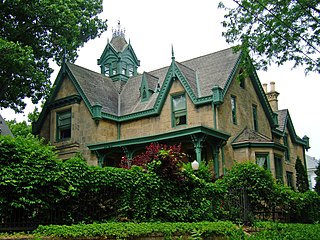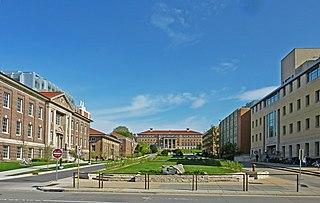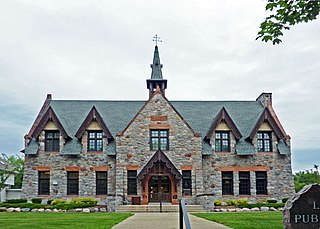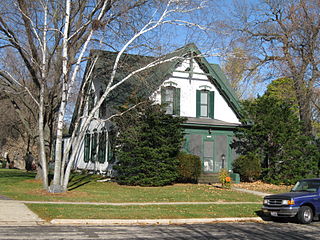
The Merchants Avenue Historic District in a residential neighborhood southeast of the downtown in Fort Atkinson, Wisconsin, composed of 33 mostly large homes on large lots within six city blocks around Merchants Avenue. It was placed on the United States National Register of Historic Places in 1986.

Washington Avenue Historic District is the historic center of Cedarburg, Wisconsin, the location of the early industry and commerce that was key to the community's development. The historic district was listed on the National Register of Historic Places (NRHP) in 1986.

Ferry & Clas was an architectural firm in Wisconsin. It designed many buildings that are listed on the National Register of Historic Places. George Bowman Ferry and Alfred Charles Clas were partners.

The Church Hill Historic District is a mid-to-upper-class residential area north of Portage's downtown. It was added to the National Register of Historic Places in 1997 for its significance in architecture and social history.

The William T. Leitch House is a well-preserved house built in 1857 a half mile northeast of the capitol square in Madison, Wisconsin. In 1975 it was added to the National Register of Historic Places, as "the best example of mid-19th century Gothic Revival style" in Madison, and for its association with the city mayors and legislator who lived there.

The Mansion Hill Historic District encompasses a part of the Mansion Hill neighborhood northwest of the capitol square in Madison, Wisconsin. In the 19th century the district was home to much of Madison's upper class, and held the largest concentration of large, ornate residences in the city, but in the 20th century it shifted to student housing. In 1997 the district was added to the National Register of Historic Places.

Saints Peter and Paul Roman Catholic Church Complex is located in Milwaukee, Wisconsin. The complex was added to the National Register of Historic Places in 1991 for its architectural significance.

The Washington Highlands Historic District is a historic subdivision in Wauwatosa, Wisconsin, planned by Hegemann & Peets starting in 1916. It was added to the National Register of Historic Places in 1989.

The Southside Historic District is a large, prestigious historic neighborhood in Racine, Wisconsin, including over 500 contributing structures in various architectural styles. It was added to the National Register of Historic Places in 1977.

The Court Street Commercial Historic District is a largely intact part of the old downtown of Richland Center, Wisconsin. It was added to the National Register of Historic Places in 1989 - a 11.2 acres (4.5 ha) historic district which included 51 contributing buildings and 20 non-contributing ones. The buildings are commercial, mostly in Late Victorian styles constructed from 1870 to 1938. Most are brick two-story buildings; a few one-story and three-story brick buildings are interspersed.

The Maple Park Historic District is a historic neighborhood that lies northwest of the downtown of Lake Geneva, Wisconsin, United States. Part of the original city plat for Lake Geneva, it was first home to early settlers before the town became known as a retreat for wealthy Chicagoans. The district was added to the National Register of Historic Places in 2005.
The West Washington-North Hi-Mount Boulevards Historic District is a historic neighborhood in Milwaukee, Wisconsin, with stylish homes built along the named streets beginning in 1912, mostly businessmen and professionals. In 1994 the district was listed on the National Register of Historic Places.

The Prairie Street Historic District is a residential historic district in Columbus, Wisconsin. The district consists of thirty-nine houses, two carriage houses, and a church along a five-block section of West Prairie Street. The oldest house in the district was built circa 1860, while the most recent was built in 1936. The district is noted for its architectural diversity, a product of the large original lots being subdivided over time and contemporary houses being built on the new lots. Architectural styles represented in the district include Italianate, Queen Anne, Stick Style, Victorian Gothic, American Craftsman, Colonial Revival, Tudor Revival, and Georgian Revival. The district includes works by Milwaukee architects Edward Townsend Mix, Henry C. Koch, and Van Ryn & DeGelleke.

The Fourth Lake Ridge Historic District is a historic neighborhood on the Lake Mendota side of the isthmus in Madison, Wisconsin, with most homes built from the 1890s to 1930s, but a few as old as the 1850s. In 1998 the historic district was added to the National Register of Historic Places.

The Henry Mall Historic District is a landscaped mall and the surrounding academic agriculture buildings on the University of Wisconsin–Madison campus, roughly laid out by architects Warren Laird and Paul Cret from 1906 to 1908, with buildings constructed from 1903 to 1961. In 1992 the district was added to the National Register of Historic Places.

The Hiram Smith Hall and Annex is part of the University of Wisconsin-Madison College of Agricultural and Life Sciences. The Hall was built in 1891 to house the first permanent dairy school in the western hemisphere, which had been established the year before. The annex was added in 1909 as the dairy school grew. In 1985 the pair were listed on the National Register of Historic Places.

The Cass-Wells Historic District is a small group of historic homes in the Yankee Hill neighborhood of Milwaukee, Wisconsin, built from 1870 to 1914 in various styles. It was listed on the National Register of Historic Places in 1986 and on the State Register of Historic Places in 1989.

The L. D. Fargo Public Library is a historic public library at 120 E. Madison Street in Lake Mills, Wisconsin.

The Lincoln Street Historic District is a largely intact group of five homes built from 1880 to around 1900 in Oregon, Wisconsin. It was added to the State and the National Register of Historic Places in 2006.

The Old Fourth Ward Historic District in Janesville, Wisconsin is a large old working-class neighborhood southwest of the downtown, comprising about 1100 contributing structures built from the 1840s to 1930. In 1990 the district was listed on the National Register of Historic Places.



















